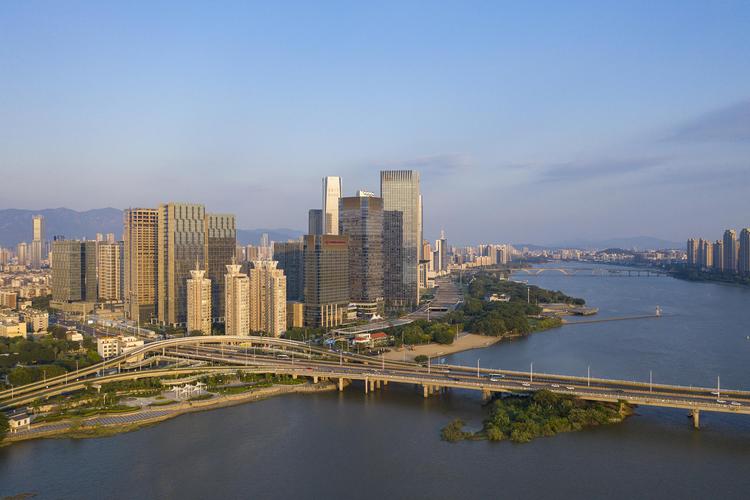Nestled between mountains and the sea in southeastern China, Fuzhou—the capital of Fujian Province—is a city where ancient traditions harmonize with modern ambitions. With a history spanning over 2,200 years and a dynamic urban landscape, Fuzhou offers travelers a captivating blend of cultural depth, scenic beauty, and culinary delights.
1. Urban Development: A Vision of Modernity
Fuzhou’s skyline tells a story of strategic growth. Anchored by the “3820” strategic plan initiated in the 1990s, the city has evolved into a hub of innovation and connectivity. Key highlights include:
- Economic Powerhouse: In 2024, Fuzhou’s GDP reached 1.42 trillion yuan, driven by industries like optoelectronics, new energy, and biomedicine.
- Smart City Initiatives: As a pioneer in China’s digital economy, Fuzhou hosts the Digital China Summit and integrates AI and cloud computing into urban management.
- Transportation Network: The city’s metro system, expanded roads (e.g., Jinshan Avenue elevated corridor), and coastal development axes like the Minjiang River Economic Belt enhance accessibility.
- Eco-Friendly Design: Known as the “City of Banyan Trees,” Fuzhou intertwines green spaces like West Lake Park with urban zones, embodying sustainability.
2. Historical Legacy: Echoes of a Millennia-Old City
Fuzhou’s roots trace back to the Han Dynasty (202 BCE), when it was established as the capital of the Minyue Kingdom. Key historical landmarks include:
- Three Lanes and Seven Alleys (Sanfang Qixiang): A UNESCO-listed Ming-Qing architectural marvel, this district birthed luminaries like Lin Zexu (anti-opium hero) and Yan Fu (translator of Western classics).
- Ancient City Layout: The “Three Hills, Two Pagodas, One River” structure—featuring Mount Wu, Yu, and Ping, alongside the White and Black Pagodas—has defined Fuzhou’s skyline since the Tang Dynasty.
- Maritime Heritage: As a key Silk Road port, Fuzhou exported tea, porcelain, and literature, while absorbing global influences visible in landmarks like the Kuliang Summer Resort’s Western-style villas.
3. Must-Visit Attractions: Nature, Culture, and Beyond
From tranquil temples to vibrant neighborhoods, Fuzhou’s attractions cater to all interests:
- Gushan (Drum Mountain): Hike or take a cable car to Buddhist temples like Yongquan Temple, surrounded by ancient rock carvings.
- Yantai Mountain: A mix of colonial-era buildings and trendy cafes, this area offers panoramic views of the Min River.
- Yongtai Yunzhong Valley: Escape to waterfalls and alpine meadows in this UNESCO Global Geopark.
- Cultural Hotspots: Explore the Fujian Museum, the historic Zhenhai Tower, and the maritime legacy of Mawei’s Shipyard Museum.
4. Culinary Journey: A Feast for the Senses
Fuzhou’s cuisine reflects its coastal and mountainous bounty, with flavors ranging from delicate to bold:
- Iconic Dishes:
• Buddha Jumps Over the Wall (佛跳墙): A luxurious stew of abalone, sea cucumber, and Shaoxing wine, simmered for hours.
• Fuzhou Fish Balls (鱼丸): Springy dumplings made with minced fish and pork, served in savory broth.
• Lychee Pork (荔枝肉): Crispy pork glazed in sweet-and-sour sauce, mimicking the shape of lychees. - Street Food Gems: Savor Bianrou (肉燕, wontons with translucent wrappers), Oyster Omelette (海蛎煎), and Guangbing (锅边糊, rice-flour soup with clams).
- Tea Culture: Don’t miss Jasmine Tea, a fragrant local specialty cultivated since the Song Dynasty.
5. Practical Tips for Travelers
- Best Time to Visit: Spring (March–May) and autumn (September–November) for mild weather.
- Transport: Use the efficient metro system; taxis and shared bikes are widely available.
- Stay: Choose heritage hotels near Sanfang Qixiang or modern options in the bustling Taijiang CBD.
Fuzhou is more than a destination—it’s an experience where history whispers through ancient lanes, innovation shapes skylines, and every meal tells a story. Whether you’re tracing the footsteps of scholars in Sanfang Qixiang or savoring a steaming bowl of fish balls, this city promises memories as rich as its heritage.
Plan your journey to Fuzhou, where the past and future dance in harmony.
